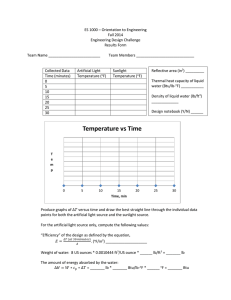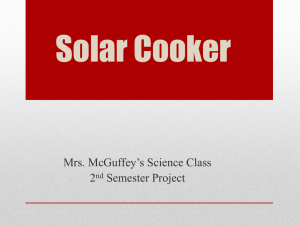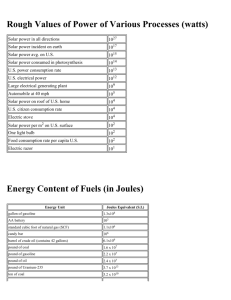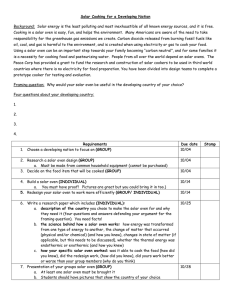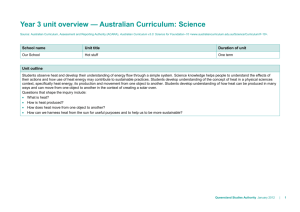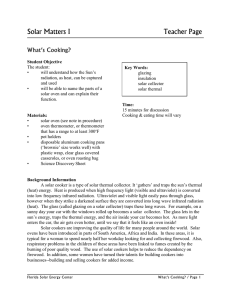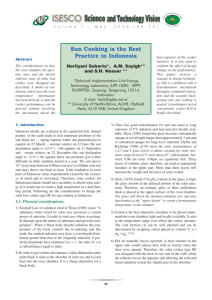Solar Oven Design Challenge
advertisement
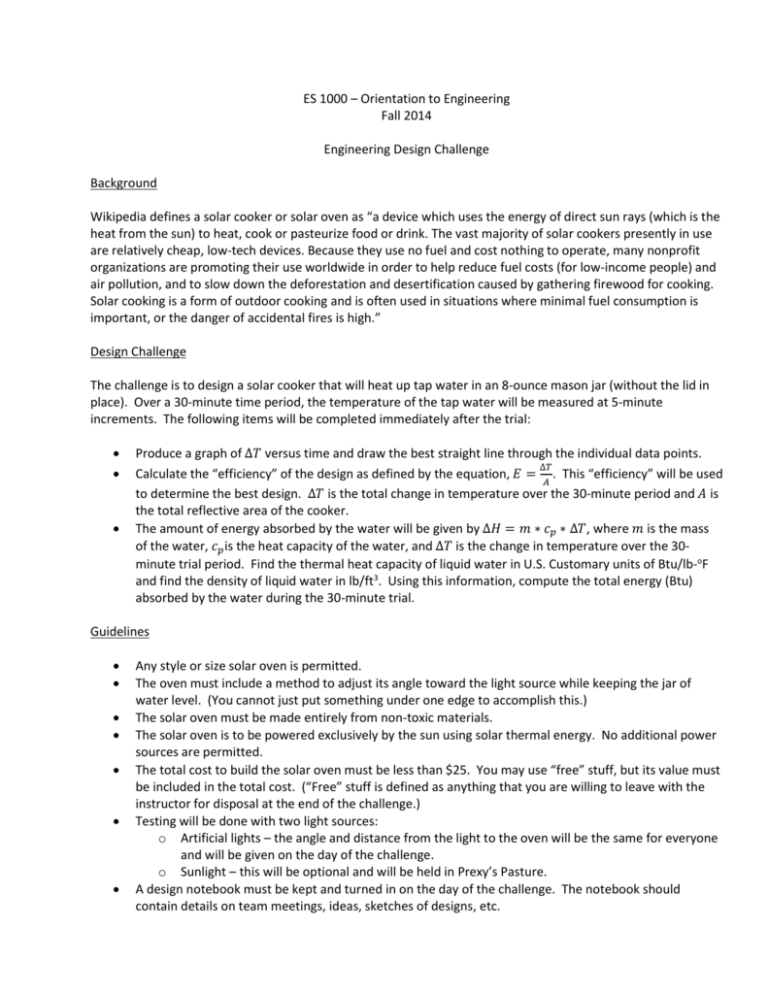
ES 1000 – Orientation to Engineering Fall 2014 Engineering Design Challenge Background Wikipedia defines a solar cooker or solar oven as “a device which uses the energy of direct sun rays (which is the heat from the sun) to heat, cook or pasteurize food or drink. The vast majority of solar cookers presently in use are relatively cheap, low-tech devices. Because they use no fuel and cost nothing to operate, many nonprofit organizations are promoting their use worldwide in order to help reduce fuel costs (for low-income people) and air pollution, and to slow down the deforestation and desertification caused by gathering firewood for cooking. Solar cooking is a form of outdoor cooking and is often used in situations where minimal fuel consumption is important, or the danger of accidental fires is high.” Design Challenge The challenge is to design a solar cooker that will heat up tap water in an 8-ounce mason jar (without the lid in place). Over a 30-minute time period, the temperature of the tap water will be measured at 5-minute increments. The following items will be completed immediately after the trial: Produce a graph of ∆𝑇 versus time and draw the best straight line through the individual data points. ∆𝑇 Calculate the “efficiency” of the design as defined by the equation, 𝐸 = 𝐴 . This “efficiency” will be used to determine the best design. ∆𝑇 is the total change in temperature over the 30-minute period and 𝐴 is the total reflective area of the cooker. The amount of energy absorbed by the water will be given by ∆𝐻 = 𝑚 ∗ 𝑐𝑝 ∗ ∆𝑇, where 𝑚 is the mass of the water, 𝑐𝑝 is the heat capacity of the water, and ∆𝑇 is the change in temperature over the 30minute trial period. Find the thermal heat capacity of liquid water in U.S. Customary units of Btu/lb-oF and find the density of liquid water in lb/ft3. Using this information, compute the total energy (Btu) absorbed by the water during the 30-minute trial. Guidelines Any style or size solar oven is permitted. The oven must include a method to adjust its angle toward the light source while keeping the jar of water level. (You cannot just put something under one edge to accomplish this.) The solar oven must be made entirely from non-toxic materials. The solar oven is to be powered exclusively by the sun using solar thermal energy. No additional power sources are permitted. The total cost to build the solar oven must be less than $25. You may use “free” stuff, but its value must be included in the total cost. (“Free” stuff is defined as anything that you are willing to leave with the instructor for disposal at the end of the challenge.) Testing will be done with two light sources: o Artificial lights – the angle and distance from the light to the oven will be the same for everyone and will be given on the day of the challenge. o Sunlight – this will be optional and will be held in Prexy’s Pasture. A design notebook must be kept and turned in on the day of the challenge. The notebook should contain details on team meetings, ideas, sketches of designs, etc. ES 1000 – Orientation to Engineering Fall 2014 Engineering Design Challenge Results Form Team Name _________________________ Collected Data Time (minutes) 0 5 10 15 20 25 30 Team Members ____________________________ Artificial Light Temperature (oF) Sunlight Temperature (oF) Reflective area (in2) _________ Thermal heat capacity of liquid water (Btu/lb-oF) ___________ Density of liquid water (lb/ft3) _____________ Design notebook (Y/N) ______ Temperature vs Time T e m p 1 0.9 0.8 0.7 0.6 0.5 0.4 0.3 0.2 0.1 0 0 5 10 15 20 25 30 Time, min Produce graphs of ∆𝑇 versus time and draw the best straight line through the individual data points for both the artificial light source and the sunlight source. For the artificial light source only, compute the following values: “Efficiency” of the design as defined by the equation, 𝐸= ∆𝑇 (𝑎𝑡 30 𝑚𝑖𝑛𝑢𝑡𝑒𝑠) o . ( F/in2) 𝐴 ____________________ Weight of water: 8 US ounces * 0.0010444 ft3/US ounce * ______ lb/ft3 = _______ lb The amount of energy absorbed by the water: ∆𝐻 = 𝑊 ∗ 𝑐𝑝 ∗ ∆𝑇 = _______ lb * _______ Btu/lb-oF * ______ oF = _______ Btu
